Do not trust "Blocked (Important) Incoming Messages" phishing emails
Phishing/ScamAlso Known As: "Blocked (Important) Incoming Messages" phishing email
Get free scan and check if your device is infected.
Remove it nowTo use full-featured product, you have to purchase a license for Combo Cleaner. Seven days free trial available. Combo Cleaner is owned and operated by RCS LT, the parent company of PCRisk.com.
What kind of email is "Blocked (Important) Incoming Messages"?
"Blocked (Important) Incoming Messages" is a spam email, which our inspection revealed to be a phishing scam. This letter attempts to deceive recipients into revealing their email account log-in credentials by claiming that a number of messages have failed to reach their inbox.
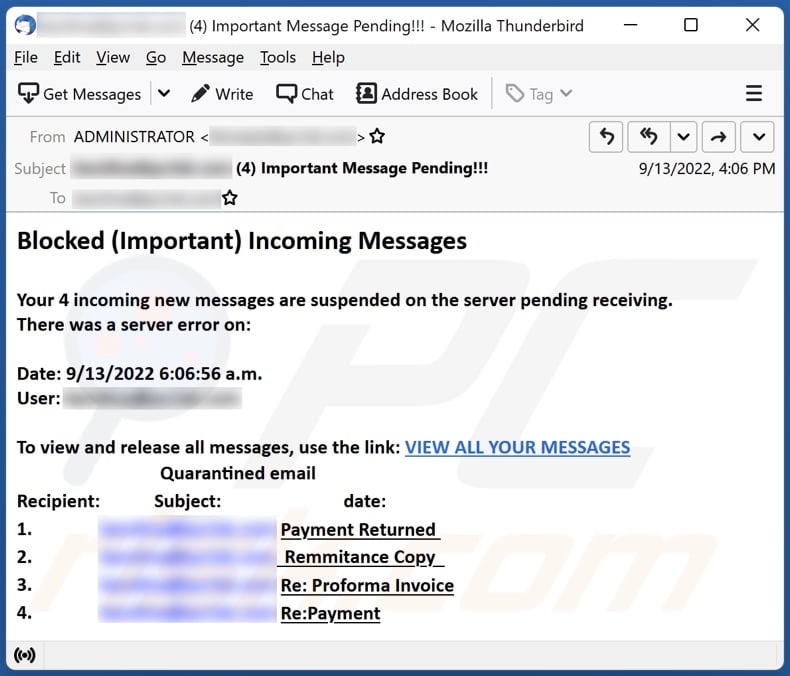
"Blocked (Important) Incoming Messages" email scam overview
The email with the subject "[recipient's_email_address] (4) Important Message Pending!!!" (may vary) informs that four new messages are pending arrival into the inbox. According to this fake letter, the emails were blocked because of a server error. The names of the nonexistent messages relate to payments.
As mentioned in the introduction, this spam email is fake, and all its claims are bogus. Therefore, when the "VIEW ALL YOUR MESSAGES" link is clicked, it results in a redirect to a phishing site. This website is presented as an email account sign-in page.
The data (i.e., email account passwords) entered into this webpage are revealed to the scammers behind this spam campaign. Victims of this scam risk more than just losing their email account, as the cyber criminals can also steal associated content (e.g., accounts, platforms, services, etc., registered with the email).
To expand upon how this unauthorized access can be abused, scammers can use stolen financial accounts (e.g., online banking, e-commerce, digital wallets, etc.) to make fraudulent transactions and/or online purchases. Cyber criminals can pretend to be the actual owners of communication accounts (e.g., email, social networking, social media, etc.) and ask the contacts/friends/followers for loans/donations or spread malware by sharing malicious files/links.
To summarize, by trusting emails like "Blocked (Important) Incoming Messages" - users can experience severe privacy issues, financial losses, and even identity theft.
If you have already provided your log-in data to a phishing website, we strongly advise changing the passwords of all potentially compromised accounts and contacting their official support without delay.
| Name | "Blocked (Important) Incoming Messages" phishing email |
| Threat Type | Phishing, Scam, Social Engineering, Fraud |
| Fake Claim | Four messages have failed to reach the recipient's inbox and are currently pending. |
| Symptoms | Unauthorized online purchases, changed online account passwords, identity theft, illegal access of the computer. |
| Distribution methods | Deceptive emails, rogue online pop-up ads, search engine poisoning techniques, misspelled domains. |
| Damage | Loss of sensitive private information, monetary loss, identity theft. |
| Malware Removal (Windows) |
To eliminate possible malware infections, scan your computer with legitimate antivirus software. Our security researchers recommend using Combo Cleaner. Download Combo CleanerTo use full-featured product, you have to purchase a license for Combo Cleaner. 7 days free trial available. Combo Cleaner is owned and operated by RCS LT, the parent company of PCRisk.com. |
Phishing spam campaign examples
"Request To Terminate/Disable Your Email", "Password Is Scheduled To Expire", and "DHL Express - CONFIDENTIALITY NOTICE" are just a few of our latest finds within the phishing email category.
Deceptive letters are used to facilitate all manner of scams, and they are often used to proliferate trojans, ransomware, and other malware. These emails can wear a broad range of disguises that may be competently crafted. Due to this and the prevalence of spam mail, we highly recommend exercising caution with incoming emails and messages.
How do spam campaigns infect computers?
Spam campaigns proliferate malware by distributing virulent files. These files can be attached to and/or linked inside the emails. Infectious files can be Microsoft Office and PDF documents, executables (.exe, .run, etc.), archives (ZIP, RAR, etc.), JavaScript, and so forth.
Once such a file is executed, run, or otherwise opened - the infection process is triggered. For example, Microsoft Office documents infect devices by executing malicious macro commands.
How to avoid installation of malware?
We advise vigilance with incoming emails and messages. The attachments and links found in suspicious/irrelevant mail must not be opened since that can result in a system infection. We recommend using Microsoft Office versions released after 2010, as they have the "Protected View" mode that prevents automatic macro execution.
However, malware is distributed using a variety of methods. Therefore, we also advise downloading only from official and trustworthy sources. Furthermore, it is crucial to activate and update software using functions/tools provided by legitimate developers, as illegal activation ("cracking") tools and third-party updates may contain malware.
Another recommendation is to be careful when browsing since fraudulent and malicious content typically appears ordinary and innocuous.
We must stress the importance of having a dependable anti-virus installed and kept up-to-date. Security programs must be used to run regular system scans and to remove threats. If you've already opened malicious attachments, we recommend running a scan with Combo Cleaner Antivirus for Windows to automatically eliminate infiltrated malware.
Text presented in the "Blocked (Important) Incoming Messages" spam email letter:
Subject: ******** (4) Important Message Pending!!!
Blocked (Important) Incoming Messages
Your 4 incoming new messages are suspended on the server pending receiving.
There was a server error on:
Date: 9/13/2022 6:06:56 a.m.
User: ********
To view and release all messages, use the link: VIEW ALL YOUR MESSAGES
Quarantined email
Recipient: Subject: date:
1. ******** Payment Returned
2. ******** Remmitance Copy
3. ******** Re: Proforma Invoice
4. ******** Re:Payment
Screenshot of the phishing website promoted by the "Blocked (Important) Incoming Messages" spam campaign:
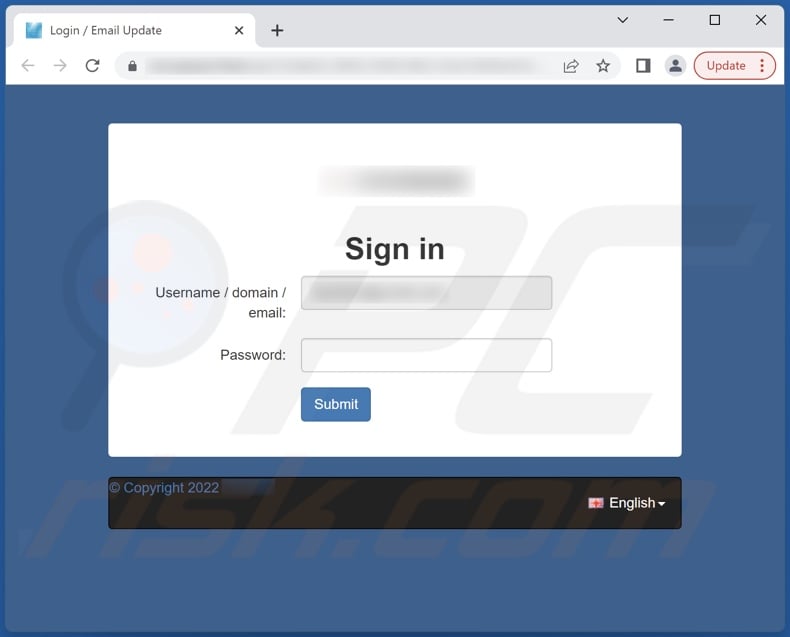
Another example of blocked incoming messages-themed spam promoting a phishing site:
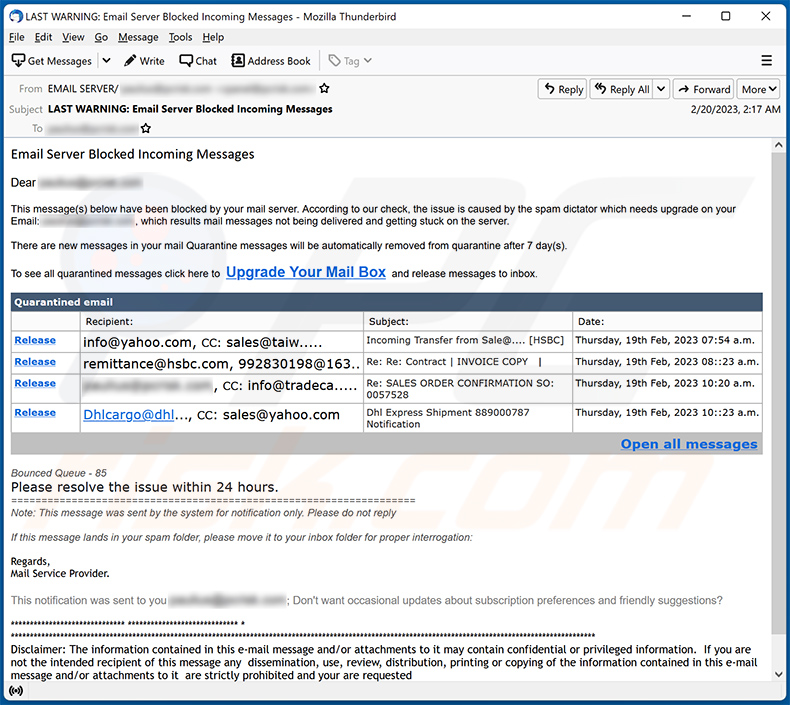
Text presented within:
Subject: LAST WARNING: Email Server Blocked Incoming Messages
Email Server Blocked Incoming Messages
Dear ********This message(s) below have been blocked by your mail server. According to our check, the issue is caused by the spam dictator which needs upgrade on your Email: ********, which results mail messages not being delivered and getting stuck on the server.
There are new messages in your mail Quarantine messages will be automatically removed from quarantine after 7 day(s).
To see all quarantined messages click here to Upgrade Your Mail Box and release messages to inbox.
Quarantined email
Recipient: Subject: Date:
Release info@yahoo.com, CC: sales@taiw..... Incoming Transfer from Sale@.... [HSBC] Thursday, 19th Feb, 2023 07:54 a.m.
Release remittance@hsbc.com, 992830198@163.. Re: Re: Contract | INVOICE COPY | Thursday, 19th Feb, 2023 08::23 a.m.
Release ********, CC: info@tradeca..... Re: SALES ORDER CONFIRMATION SO: 0057528 Thursday, 19th Feb, 2023 10:20 a.m.
Release Dhlcargo@dhl..., CC: sales@yahoo.com
Dhl Express Shipment 889000787 Notification Thursday, 19th Feb, 2023 10::23 a.m.
Open all messagesBounced Queue - 85
Please resolve the issue within 24 hours.
===================================================================
Note: This message was sent by the system for notification only. Please do not replyIf this message lands in your spam folder, please move it to your inbox folder for proper interrogation:
Regards,
Mail Service Provider.This notification was sent to you ********; Don't want occasional updates about subscription preferences and friendly suggestions?
Screenshot of the promoted phishing site:
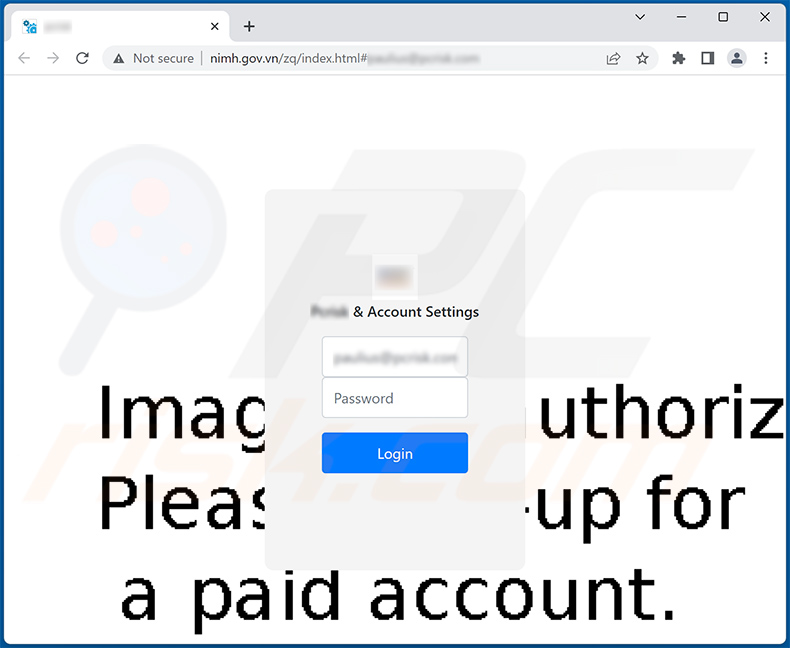
Another example of an email from "Blocked (Important) Incoming Messages" spam campaign:
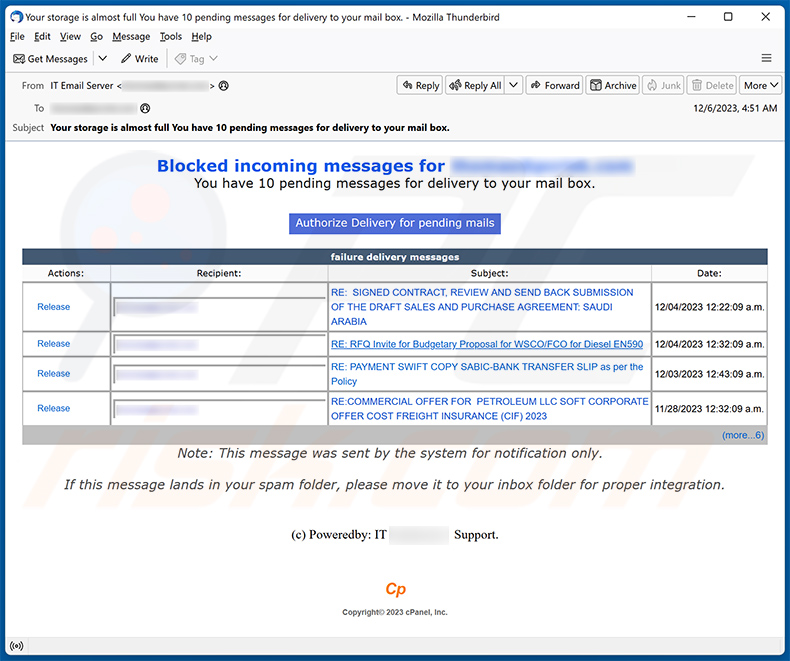
Text presented within:
Subject: Your storage is almost full You have 10 pending messages for delivery to your mail box.
Blocked incoming messages for ********
You have 10 pending messages for delivery to your mail box.
Authorize Delivery for pending mailsfailure delivery messages
Actions: Recipient: Subject: Date:
Release ******** RE: SIGNED CONTRACT, REVIEW AND SEND BACK SUBMISSION OF THE DRAFT SALES AND PURCHASE AGREEMENT: SAUDI ARABIA 12/04/2023 12:22:09 a.m.
Release ******** RE: RFQ Invite for Budgetary Proposal for WSCO/FCO for Diesel EN590 12/04/2023 12:32:09 a.m.
Release ******** RE: PAYMENT SWIFT COPY SABIC-BANK TRANSFER SLIP as per the Policy 12/03/2023 12:43:09 a.m.
Release ******** RE:COMMERCIAL OFFER FOR PETROLEUM LLC SOFT CORPORATE OFFER COST FREIGHT INSURANCE (CIF) 2023 11/28/2023 12:32:09 a.m.
(more...6)Note: This message was sent by the system for notification only.
If this message lands in your spam folder, please move it to your inbox folder for proper integration.(c) Poweredby: IT ******** Support.
Cp
Copyright© 2023 cPanel, Inc.
Screenshot of the promoted phishing site:
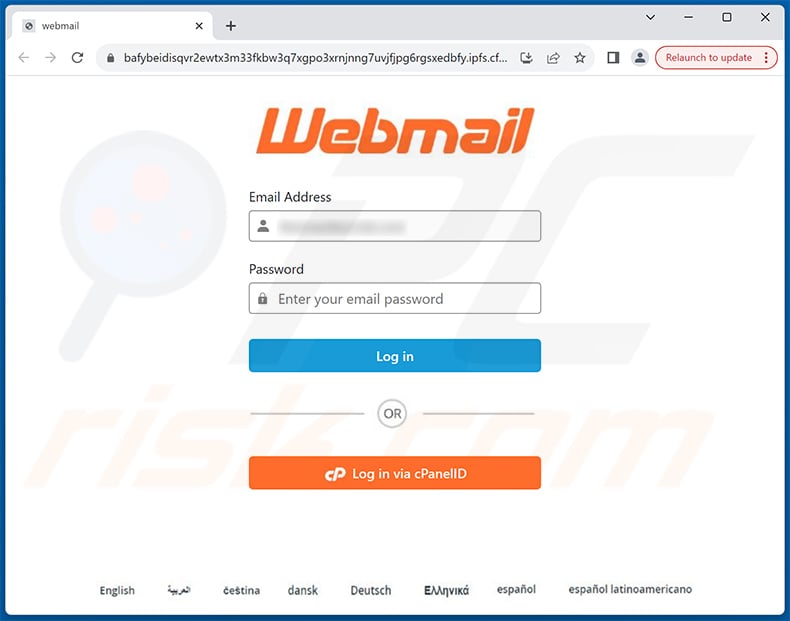
Yet another example of an email from "Blocked (Important) Incoming Messages" spam campaign:
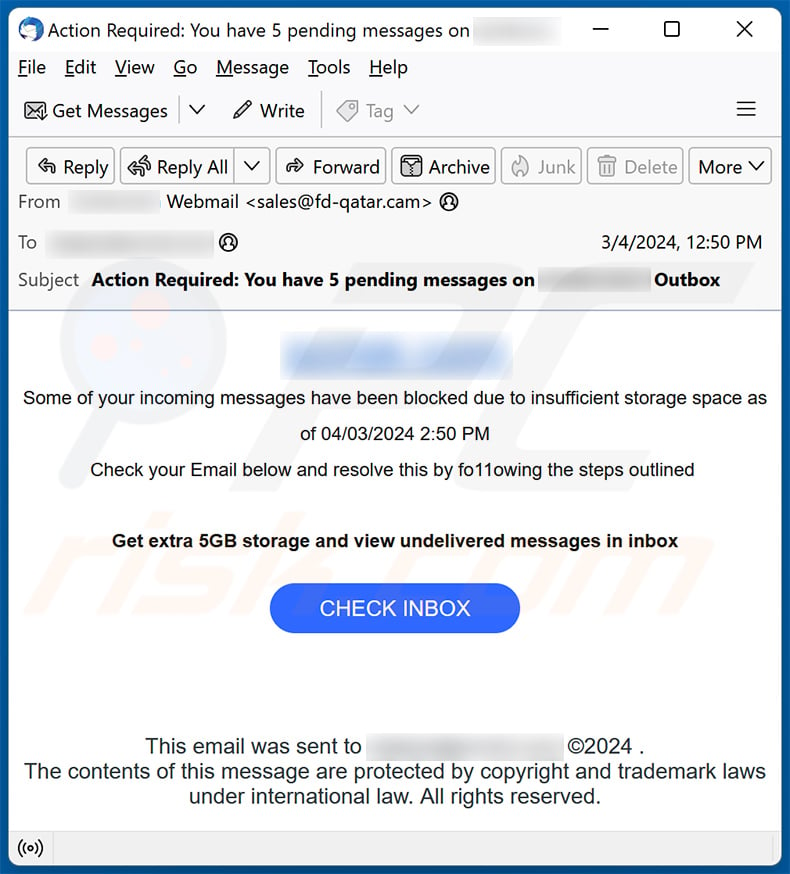
Text presented within:
Subject: Action Required: You have 5 pending messages on ********'s Outbox
********
Some of your incoming messages have been blocked due to insufficient storage space as of 04/03/2024 2:50 PM
Check your Email below and resolve this by fo11owing the steps outlinedGet extra 5GB storage and view undelivered messages in inbox
CHECK INBOX
Instant automatic malware removal:
Manual threat removal might be a lengthy and complicated process that requires advanced IT skills. Combo Cleaner is a professional automatic malware removal tool that is recommended to get rid of malware. Download it by clicking the button below:
DOWNLOAD Combo CleanerBy downloading any software listed on this website you agree to our Privacy Policy and Terms of Use. To use full-featured product, you have to purchase a license for Combo Cleaner. 7 days free trial available. Combo Cleaner is owned and operated by RCS LT, the parent company of PCRisk.com.
Quick menu:
- What is "Blocked (Important) Incoming Messages" phishing email?
- Types of malicious emails.
- How to spot a malicious email?
- What to do if you fell for an email scam?
Types of malicious emails:
![]() Phishing Emails
Phishing Emails
Most commonly, cybercriminals use deceptive emails to trick Internet users into giving away their sensitive private information, for example, login information for various online services, email accounts, or online banking information.
Such attacks are called phishing. In a phishing attack, cybercriminals usually send an email message with some popular service logo (for example, Microsoft, DHL, Amazon, Netflix), create urgency (wrong shipping address, expired password, etc.), and place a link which they hope their potential victims will click on.
After clicking the link presented in such email message, victims are redirected to a fake website that looks identical or extremely similar to the original one. Victims are then asked to enter their password, credit card details, or some other information that gets stolen by cybercriminals.
![]() Emails with Malicious Attachments
Emails with Malicious Attachments
Another popular attack vector is email spam with malicious attachments that infect users' computers with malware. Malicious attachments usually carry trojans that are capable of stealing passwords, banking information, and other sensitive information.
In such attacks, cybercriminals' main goal is to trick their potential victims into opening an infected email attachment. To achieve this goal, email messages usually talk about recently received invoices, faxes, or voice messages.
If a potential victim falls for the lure and opens the attachment, their computers get infected, and cybercriminals can collect a lot of sensitive information.
While it's a more complicated method to steal personal information (spam filters and antivirus programs usually detect such attempts), if successful, cybercriminals can get a much wider array of data and can collect information for a long period of time.
![]() Sextortion Emails
Sextortion Emails
This is a type of phishing. In this case, users receive an email claiming that a cybercriminal could access the webcam of the potential victim and has a video recording of one's masturbation.
To get rid of the video, victims are asked to pay a ransom (usually using Bitcoin or another cryptocurrency). Nevertheless, all of these claims are false - users who receive such emails should ignore and delete them.
How to spot a malicious email?
While cyber criminals try to make their lure emails look trustworthy, here are some things that you should look for when trying to spot a phishing email:
- Check the sender's ("from") email address: Hover your mouse over the "from" address and check if it's legitimate. For example, if you received an email from Microsoft, be sure to check if the email address is @microsoft.com and not something suspicious like @m1crosoft.com, @microsfot.com, @account-security-noreply.com, etc.
- Check for generic greetings: If the greeting in the email is "Dear user", "Dear @youremail.com", "Dear valued customer", this should raise suspiciousness. Most commonly, companies call you by your name. Lack of this information could signal a phishing attempt.
- Check the links in the email: Hover your mouse over the link presented in the email, if the link that appears seems suspicious, don't click it. For example, if you received an email from Microsoft and the link in the email shows that it will go to firebasestorage.googleapis.com/v0... you shouldn't trust it. It's best not to click any links in the emails but to visit the company website that sent you the email in the first place.
- Don't blindly trust email attachments: Most commonly, legitimate companies will ask you to log in to their website and to view any documents there; if you received an email with an attachment, it's a good idea to scan it with an antivirus application. Infected email attachments are a common attack vector used by cybercriminals.
To minimise the risk of opening phishing and malicious emails we recommend using Combo Cleaner Antivirus for Windows.
Example of a spam email:

What to do if you fell for an email scam?
- If you clicked on a link in a phishing email and entered your password - be sure to change your password as soon as possible. Usually, cybercriminals collect stolen credentials and then sell them to other groups that use them for malicious purposes. If you change your password in a timely manner, there's a chance that criminals won't have enough time to do any damage.
- If you entered your credit card information - contact your bank as soon as possible and explain the situation. There's a good chance that you will need to cancel your compromised credit card and get a new one.
- If you see any signs of identity theft - you should immediately contact the Federal Trade Commission. This institution will collect information about your situation and create a personal recovery plan.
- If you opened a malicious attachment - your computer is probably infected, you should scan it with a reputable antivirus application. For this purpose, we recommend using Combo Cleaner Antivirus for Windows.
- Help other Internet users - report phishing emails to Anti-Phishing Working Group, FBI’s Internet Crime Complaint Center, National Fraud Information Center and U.S. Department of Justice.
Frequently Asked Questions (FAQ)
Why did I receive this email?
Cyber criminals distribute spam emails in large-scale operations - hence, thousands of users receive identical messages.
I have provided my personal information when tricked by this spam email, what should I do?
If you have disclosed log-in credentials - immediately change the passwords of all potentially exposed accounts and inform their official support. And if you have revealed other private information (e.g., ID card details, credit card numbers, etc.) - contact the appropriate authorities without delay.
I have read a spam email but didn't open the attachment, is my computer infected?
No, opening/reading an email will not initiate any system infection processes. The malware download/installation chains are jumpstarted by opening the attachments or links found in spam mail.
I have downloaded and opened a file attached to a spam email, is my computer infected?
Whether an infection occurred might depend on the opened file's format. Executables (.exe, .run, etc.) infect devices almost without fail the moment they are opened. While documents (.xls, .doc, .pdf, etc.) may need additional user interactions (e.g., enabling macro commands) to begin downloading/installing malicious programs.
Will Combo Cleaner remove malware infections present in email attachments?
Yes, Combo Cleaner is capable of detecting and eliminating practically all known malware infections. It must be emphasized that performing a full system scan is essential - since high-end malicious software typically hides deep within systems.
Share:

Tomas Meskauskas
Expert security researcher, professional malware analyst
I am passionate about computer security and technology. I have an experience of over 10 years working in various companies related to computer technical issue solving and Internet security. I have been working as an author and editor for pcrisk.com since 2010. Follow me on Twitter and LinkedIn to stay informed about the latest online security threats.
PCrisk security portal is brought by a company RCS LT.
Joined forces of security researchers help educate computer users about the latest online security threats. More information about the company RCS LT.
Our malware removal guides are free. However, if you want to support us you can send us a donation.
DonatePCrisk security portal is brought by a company RCS LT.
Joined forces of security researchers help educate computer users about the latest online security threats. More information about the company RCS LT.
Our malware removal guides are free. However, if you want to support us you can send us a donation.
Donate
▼ Show Discussion